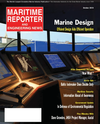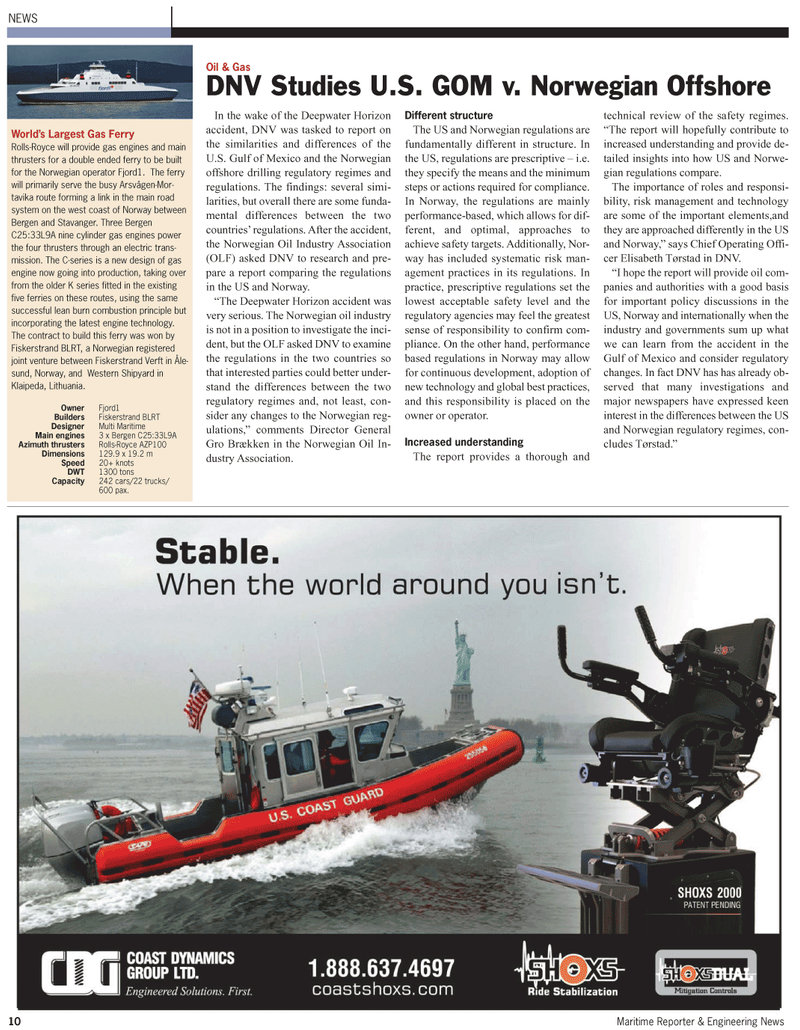
Page 10: of Maritime Reporter Magazine (October 2010)
Marine Design Annual
Read this page in Pdf, Flash or Html5 edition of October 2010 Maritime Reporter Magazine
10 Maritime Reporter & Engineering News
In the wake of the Deepwater Horizon accident, DNV was tasked to report on the similarities and differences of the
U.S. Gulf of Mexico and the Norwegian offshore drilling regulatory regimes and regulations. The findings: several simi- larities, but overall there are some funda- mental differences between the two countries’ regulations. After the accident, the Norwegian Oil Industry Association (OLF) asked DNV to research and pre- pare a report comparing the regulations in the US and Norway. “The Deepwater Horizon accident was very serious. The Norwegian oil industry is not in a position to investigate the inci- dent, but the OLF asked DNV to examine the regulations in the two countries so that interested parties could better under- stand the differences between the two regulatory regimes and, not least, con- sider any changes to the Norwegian reg- ulations,” comments Director General
Gro Brækken in the Norwegian Oil In- dustry Association.
Different structure
The US and Norwegian regulations are fundamentally different in structure. In the US, regulations are prescriptive – i.e. they specify the means and the minimum steps or actions required for compliance.
In Norway, the regulations are mainly performance-based, which allows for dif- ferent, and optimal, approaches to achieve safety targets. Additionally, Nor- way has included systematic risk man- agement practices in its regulations. In practice, prescriptive regulations set the lowest acceptable safety level and the regulatory agencies may feel the greatest sense of responsibility to confirm com- pliance. On the other hand, performance based regulations in Norway may allow for continuous development, adoption of new technology and global best practices, and this responsibility is placed on the owner or operator.
Increased understanding
The report provides a thorough and technical review of the safety regimes. “The report will hopefully contribute to increased understanding and provide de- tailed insights into how US and Norwe- gian regulations compare.
The importance of roles and responsi- bility, risk management and technology are some of the important elements,and they are approached differently in the US and Norway,” says Chief Operating Offi- cer Elisabeth Tørstad in DNV. “I hope the report will provide oil com- panies and authorities with a good basis for important policy discussions in the
US, Norway and internationally when the industry and governments sum up what we can learn from the accident in the
Gulf of Mexico and consider regulatory changes. In fact DNV has has already ob- served that many investigations and major newspapers have expressed keen interest in the differences between the US and Norwegian regulatory regimes, con- cludes Tørstad.”
NEWS
Oil & Gas
DNV Studies U.S. GOM v. Norwegian Offshore
World’s Largest Gas Ferry
Rolls-Royce will provide gas engines and main thrusters for a double ended ferry to be built for the Norwegian operator Fjord1. The ferry will primarily serve the busy Arsvågen-Mor- tavika route forming a link in the main road system on the west coast of Norway between
Bergen and Stavanger. Three Bergen
C25:33L9A nine cylinder gas engines power the four thrusters through an electric trans- mission. The C-series is a new design of gas engine now going into production, taking over from the older K series fitted in the existing five ferries on these routes, using the same successful lean burn combustion principle but incorporating the latest engine technology.
The contract to build this ferry was won by
Fiskerstrand BLRT, a Norwegian registered joint venture between Fiskerstrand Verft in Åle- sund, Norway, and Western Shipyard in
Klaipeda, Lithuania.
Owner Fjord1
Builders Fiskerstrand BLRT
Designer Multi Maritime
Main engines 3 x Bergen C25:33L9A
Azimuth thrusters Rolls-Royce AZP100
Dimensions 129.9 x 19.2 m
Speed 20+ knots
DWT 1300 tons
Capacity 242 cars/22 trucks/ 600 pax.

 9
9

 11
11
